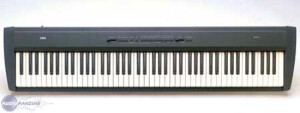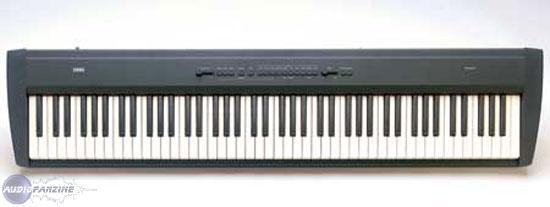View other reviews for this product:
« Korg SP-200 »
Published on 01/01/04 at 15:00Bought used as a rental return in Vancouver, Canada.
The Korg SP-200 has all the essential features of a quality digital stage piano, and is ideal for piano students who'd like to try some other sounds. Gigging musicians will find it a pleasure to play, but might find some of the features a bit limiting for stage performance.
The piano, electric piano, harpsichord, vibraphone, pipe organ, and clavinet sounds are excellent. Though not quite as grand-piano-like as those on Yamaha's P series stage pianos, the weighted keyboard is very fine indeed.
The control layout -- a row of buttons with LEDs, and just two sliders for volume and metronome tempo -- takes an excellent less-is-more approach, making the SP-200 easy to use for beginners.
Korg claims 60-note polyphony (simultaneous notes) for ther SP-200, but that's not always true. Some of the better sounds, like the first two stereo grand pianos, use two sets of oscillators and reduce polyphony to 30 notes, while the reverb and chorus reduce polyphony still further. If you layer two complex sounds and add effects, it's not hard to make notes cut off if you hold down the sustain pedal and play a few two-handed chords. On the other hand, if you use the lovely mono grand piano with no effects, it's nearly impossible to make that happen, so whether the polyphony limits are an issue depends on what you want to do.
The jazz/rock organ and synth string/choir sounds are merely adequate to good. There is no way to store custom user settings (for reverb, key-touch sensitivity, etc.), so when you turn the keyboard off and on, everything reverts to factory settings, which is why the SP-200 might not be best for those who primarily use it onstage.
The SP-200 can act as a MIDI controller or sound source, but neither is its forte -- it is designed to be plugged into some speakers, turned on, and played. Those seeking a weighted keyboard controller probably want other features, such as a pitch bend wheel, that the SP-200 lacks.
The case is about as small as it can be for a weighted, full-88-key stage piano, and at 40 pounds it is even relatively light. All the connector plugs are on the back, even for headphones, which is too bad, since a front-mounted phone jack would be more useful. There is only a single headphone jack, and no line-in to play along with CDs. The power adapter is a standard "wall wart" type with a small plug, rather than a more robust three-prong plug. The included damper pedal is just a footswitch, though a separate piano-style half-damper pedal is available.
For compact, high-quality, excellent sounding stage pianos in this price range, it's a tough competition between the SP-200 and comparable models such as Yamaha's P60 and P90, Kurzweil's SP88X, Roland's RD models, and a few from other manufacturers. The SP-200 acquits itself well, and can be a wise investment if you understand its few limitations in advance.
This review was originally published on http://www.musicgearreview.com
The Korg SP-200 has all the essential features of a quality digital stage piano, and is ideal for piano students who'd like to try some other sounds. Gigging musicians will find it a pleasure to play, but might find some of the features a bit limiting for stage performance.
The piano, electric piano, harpsichord, vibraphone, pipe organ, and clavinet sounds are excellent. Though not quite as grand-piano-like as those on Yamaha's P series stage pianos, the weighted keyboard is very fine indeed.
The control layout -- a row of buttons with LEDs, and just two sliders for volume and metronome tempo -- takes an excellent less-is-more approach, making the SP-200 easy to use for beginners.
Korg claims 60-note polyphony (simultaneous notes) for ther SP-200, but that's not always true. Some of the better sounds, like the first two stereo grand pianos, use two sets of oscillators and reduce polyphony to 30 notes, while the reverb and chorus reduce polyphony still further. If you layer two complex sounds and add effects, it's not hard to make notes cut off if you hold down the sustain pedal and play a few two-handed chords. On the other hand, if you use the lovely mono grand piano with no effects, it's nearly impossible to make that happen, so whether the polyphony limits are an issue depends on what you want to do.
The jazz/rock organ and synth string/choir sounds are merely adequate to good. There is no way to store custom user settings (for reverb, key-touch sensitivity, etc.), so when you turn the keyboard off and on, everything reverts to factory settings, which is why the SP-200 might not be best for those who primarily use it onstage.
The SP-200 can act as a MIDI controller or sound source, but neither is its forte -- it is designed to be plugged into some speakers, turned on, and played. Those seeking a weighted keyboard controller probably want other features, such as a pitch bend wheel, that the SP-200 lacks.
The case is about as small as it can be for a weighted, full-88-key stage piano, and at 40 pounds it is even relatively light. All the connector plugs are on the back, even for headphones, which is too bad, since a front-mounted phone jack would be more useful. There is only a single headphone jack, and no line-in to play along with CDs. The power adapter is a standard "wall wart" type with a small plug, rather than a more robust three-prong plug. The included damper pedal is just a footswitch, though a separate piano-style half-damper pedal is available.
For compact, high-quality, excellent sounding stage pianos in this price range, it's a tough competition between the SP-200 and comparable models such as Yamaha's P60 and P90, Kurzweil's SP88X, Roland's RD models, and a few from other manufacturers. The SP-200 acquits itself well, and can be a wise investment if you understand its few limitations in advance.
This review was originally published on http://www.musicgearreview.com



